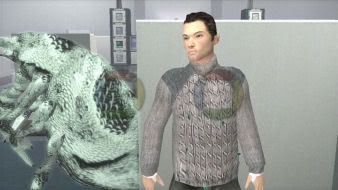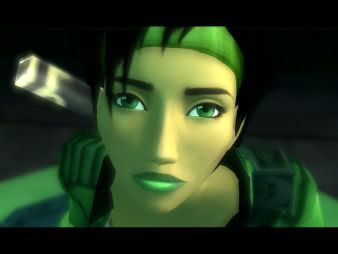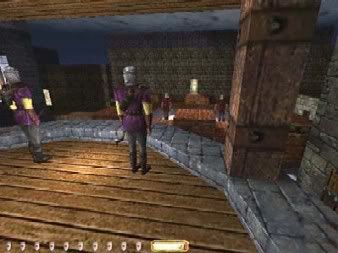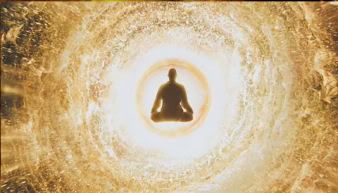Why I prefer FEAR to Half-Life 2

Yes, you read that title correctly. Yes, I prefer FEAR to Half-Life 2, and a microscopic ripple of controversy spreads around the world. Henry Winchester: Does he really prefer FEAR to Half-Life 2?
FEAR is a criminally dumb game. A first-person-horror-shooter set on an unending 80s industrial estate, with an unending supply of identikit bad guys, and an almost unending mildly diverting story. Half-Life 2 on the other hand, offers endless variety of locations, bad guys and a slightly more diverting story.Why, then, would I prefer FEAR to Half-Life 2? Two words: com-bat. Take a look at the differences in combat between Half-Life and Half-Life 2: there aren't that many. Sure, they improved the AI, and the gravity gun makes things a bit more fun; but other than that it's pretty much the same. Now, compare the combat in Half-Life 2 with the combat in FEAR. FEAR has lean keys, and kung-fu style special moves, and slow-motion. Half-Life 2 has none of these things, in Half-Life 2 it's as simple as aim and shoot. In FEAR, the combat is obviously what they spent most of the development time and money on. And it's paid off. FEAR's combat is actually completely perfect.Your average FEAR level follows a fairly standard algorithm. You're walking along a seemingly abandoned 80s industrial estate corridor. The lights start to flicker, you get some creepy "origin unknown" static on your radio and a spooky dead girl runs across the screen, sometimes a little too close for comfort. What's going to be around the next corner? Do you really want to know? You persevere, and the tension seeps back in. And then it happens.FUCK ME! WHAT WAS THAT? A FUCKING SOLDIER!It's truly gut-churning, but the best bit is your response. A few taps on the keyboard and you're in slow motion, and blam! you shoot him in the head. But maybe he's not dead, so a few taps more and you've flying kicked him across the room. It's a truly beautiful slice of chaos, with clouds of dust and a haze of blood intermingling in slow motion as a limp body cartwheels to its final resting place. This is gaming Evian: a beautiful, clear moment of triumph. Forget Crysis or Alan Wake trying to do beauty; FEAR is everything a game should be.FEAR does simply repeat this formula ad nauseaum, but the tactile sense of the combat ensured that I never got bored. Half-Life 2, on the other hand, tries to be the jack of all trades but ends up master of none. It does everything mediocrally, but nothing all that well. The driving moments are good, but soon become tiring. Alyx Vance is annoying (I don't remember Tails telling you what to do in Sonic the Hedgehog 2). And the NPC sections are painfully clumsy. This is where Half-Life 2, and the subsequent episodes have really let us down - in Half-Life there was a terrific sense of isolation, of being placed in the centre of a disaster and being utterly alone, save a few feeble scientists and security guards. In Half-Life 2 there's always someone there, watching over you, telling you what to do next. If Half-Life's scientists were signposts directing you to the game's action, Half-Life 2's are puppetmasters telling the player exactly what they must do. FEAR utterly captures that isolation, that panic. And it exploits it masterfully.Labels: Review
Fahrenheit

Are games growing up? Is there a new generation of games emerging that rely on character and narrative suspense to provide on-screen tension, as opposed to kung-fu and marauding aliens? Ostensibly an adventure game, David Cage's Fahrenheit could be seen as a significant turning point in games coming round to integrate more complex ideas and new focuses in interactive story-telling.
The beauty of Fahrenheit lies in its exposition. We begin the game as Lucas Kane, a young man with more than a passing resemblance to Shenmue's Ryu. Late one night in the toilets of a New York diner, Lucas inexplicably kills a stranger. The game then switches to follow Carla Valenti and Tyler Miles, a pair of detectives investigating the case. What happens then is a brilliantly imaginative twist: as we follow both killer and cops, our sympathies are increasingly torn between Lucas's bewildered fugitive and Carla and Tyler's quest for justice. This dichotomy would have worked better had we been able to alter the relationships between the characters (although to a certain degree we can), but it still makes for interesting and genuinely surprising gameplay as we switch between hunter and hunted.
Lucas and Carla have to be the most fully-realised and well-written game characters I've ever played. Although the graphics are nothing but functional, the characters are nuanced, have believable backstories and – most importantly - you end up genuinely caring about them. There are two (infamous) sex scenes in the game, one of which is very well-integrated and natural and adds a great deal Lucas's character, the other is a little more unexpected and far-fetched.
The way the gameplay is woven into the plot is highly proficient. The game consists of scenes - not levels - each of which includes some form of mini-game, being either Shenmue-style reaction tests or endurance tests in which the left and right cursors must be alternately mashed. The best sequences involve both, one sequence sees Kane pursued around his office by giant ticks (no, really), and the player has to use a combination of both reaction tasks and button mashing in order to escape. It's genuinely heart-pounding stuff, but you will inevitably find yourself concentrating more on which buttons to press over the action in the background.
And to begin with, the way the gameplay and plot are intertwined is phenomenal, elevating both the story and the challenges. But it is also here that lies the games biggest flaw: it tries to have its cake and eat it. For any game to remain interesting and fun, it must progressively increase the challenge it presents, until reaching a final point in which all the skills the player has learned have to be put to the test. Traditionally, storytelling works in much the same way, providing increasing challenges until a final point of breakthrough. But the essential thing to remember here is that game challenges and story challenges are not the same.
Fahrenheit does a very good job of establishing its world, but falls apart when trying to shift from a story-led game into a game-led story. The ante is upped far too much in trying to create exciting game challenges, which in turn pushes any narrative cohesion and the surprising degree of realism out of the window. The moment the game begins to feature an alien subplot is the moment the game falls apart - I remember being similarly aghast when the "greys" and Area 51 turned up in Deus Ex. They felt like lazy and unnecessary game elements then, and that was almost seven years ago. The finale of Fahrenheit is a confusing and clumsy mix of ancient and modern conspiracy theories, with an embarrassingly dated touch of The Matrix thrown in. The worst aspect of this is that it feels so utterly removed from the compelling and humane opening of the game.
Having said that, it's hard to know exactly what Fahrenheit should have done - it is equally cursed and blessed by the initially perfect ratio of gameplay and storytelling, and it obviously couldn't remain within the confines of its established world. But did it have to become so ridiculous so quickly?
One day, there will be a game capable of perfectly balancing complex narrative and characters with decent and unique gameplay, without having to switch to ludicrous speed. But Fahrenheit is not it. Fahrenheit is a definite, positive stepping stone in terms of games growing up, and half of it is probably the most confidently mature game I've ever played. But designers definitely need to realise that less is more, and that we don't necessarily need kung-fu and malevolent aliens to make a good game.
82%
Labels: Review
Beyond Good & Evil

The fact that my PC is getting more and more decrepit has certain advantages, namely that I find myself playing more obscure games from a few years back that I probably wouldn't have considered when they came out. After much searching I finally tracked down a copy of Michel Ancel's
Beyond Good & Evil gathering dust in my local PC World. I'd heard a lot about the game, it was often mentioned as being something of a neglected classic.
Having now played the game, I can see why it's regarded so highly but sold so poorly. It's not a great game, it doesn't really do anything that original and it certainly feels a bit too short. But when it comes together, somehow it works very well.
Being a PC-based gamer, I'm not used to games being actually fun. They're usual morose, sombre pieces with oppression and darkness being the order of the day. But
BG&E is permeated with a light, cartoony atmosphere, and even when it does become more heavy it's still good fun. It reminded me of my Dreamcast days (am I sounding elderly yet?), of games like
Shenmue and
Jet Set Radio and
Rez, which proved that games don't always have to be about fighting off alien invasions, and that if the universe of the game is good enough then it doesn't matter if the game plays poorly.
But
BG&E is about an alien invasion. It's about a planet under the control of an oppressive alien regime (
HL2 came a year later by the way), and it's up to our cunning reporter Jade to un-oppress the regime. There's a few fairly predictable plot twists, a couple of rather incompetent sidekicks (
HL2 again) and a lot of subgames, which range from actually quite good to fairly infuriating.
If there are good things about the game it's that it moves pretty fast and doesn't ever get too boring, and it looks fairly pretty, even by today's standards. But it feels like it's borrowing too heavily from other games, the hovercraft races (have I mentioned
HL2 yet?) seem to be a merely modified version of
Pod Racer on the N64, the shooty bits resemble the aforementioned
Rez, and the runny adventure bits (it's not a game about diarrhoea) are so generically platformery that I can't even begin to list the games it resembles. But it's all done with enough verve to just about carry it off.
At the end of the day,
BG&E is a console game on the PC, which is precisely what it is, obviously. Never too deep or challenging, in many ways it feels like the last of a species of fun, accessible console games about to made extinct under a meteor of franchises, ultra-real FPSs and online RPGs.
Labels: Review
Secret Files: Tunguska

My review of
Secret Files: Tunguska, which appeared in the January issue of PCGamer.
Tunguska, if you don’t know, or didn’t see that episode of the X-Files, is a region in Siberia famous for a mysterious huge explosion which occurred in 1908. To this day, the cause remains a mystery, and scientists have touted various theories from a comet exploding before impact to UFOs or one of Nikola Tesla’s experiments going wrong. My theory, however, is that the Tunguska event was simply an explosion of mediocrity, caused by an inexplicable mingling of tweed jackets, Richard and Judy and easy listening tapes. And certainly, the epicentre of this explosion of indifference would have been Secret Files: Tunguska.
In the game take we the role of Nina Kalenkov, who can be described using words like “spunky,” “heroine” and “kleptomaniacal”. Nina’s dad, who was researching the Tunguska event, has mysteriously disappeared without a trace. Actually, that’s a big lie: he has left a trace the manner of some incredibly esoteric clues, all of which seem to be attached to the tail end of a woefully obscure puzzle, which in turn lead to a tedious international trail of lies, conspiracies and cults.
And that brings us to the puzzles. Whereas in Lucasarts adventures the puzzles and story were beautifully intertwined, here they just feel awkward and obscure. Every one involves clunkily combining every single thing in your inventory until they work, and none of the puzzles seem to make any logical sense. For example: a man’s on the phone and you want to listen to his conversation. But rather than simply pressing your ear against the window, you tape your cellphone to a handy cat, let it in to the house and then call it from the phone box outside. What’s not explained is how exactly this lets you listen in - does the cat answer the phone?
The story itself is reasonably interesting, but any intrigue is obliterated by the sheer monotony of the endless chain of puzzles. People who love their point-and-clicks might find some value here, and it could make a perfect gift for someone’s weird mum. But if not, avoid it like the Siberian winter.
52%Labels: Review
Thief 2: The Metal Age

After approximately a year of playing
Thief 2 (on and off, not constantly), I've reached the final level. It's an incredible game, and one that I'm certainly going to revisit.
To begin with I found
Thief 2 incredibly hard to get in to - I think I started it about half a dozen times before even getting past the first level. It has an oddly sparse, angular graphical style which probably looks even odder and sparser when played on today's maximum resolution. That's not to say it doesn't look good though, and it certainly has its moments in terms of design.
But where
Thief 2 really comes into its own is in the level design. The way I play
Thief 2 is as follows, and explains why I've probably spent so long playing it: I start playing a level, and whilst doing so I think to myself "this is pretty boring, I don't actually like it all that much and there doesn't seem to be anything going on." So I stop playing.
Then, two or three days later I find myself thinking about the level, and the whole "I wonder what's around that next corner?" thing kicks in. So I boot up the game again, and start playing and I think to myself "Wow! This level's actually pretty good. Now what's down this path? Wow! A whole boat! And pirates too!" It's a game in which exploration and curiosity are an integral part of the gameplay.
The other thing that elevates
Thief 2 to genius game status is the way it respects the player's intelligence. It's not an easy game to play by any means. Playing games is about learning how to "break" them; how to trick the AI, how to use levels to your advantage.
Half-Life is an easy game to "break", it's accessible and never presents too much of a challenge. But
Thief 2, on the other hand, excels at being very difficult, even on easier diffculty settings. It's indicative of a game that's obviously had a lot of care and attention poured into it, feeling more like the work of some nobel gamesmith working in an ancient forge than a team of programmers sat round workstations.
If
Half-Life is the loud, photogenic hey-look-at-me offspring of
Doom,
Thief 2 is its smarter, moodier older brother. It doesn't immediately grab you in the way
Half-Life does, it's less linear and less accessible and fairly uneven. But the stakes are so much higher, the rewards so much more fruitful, and as a whole it's a far more enjoyable experience.
Now I've moved on to
System Shock 2, so expect a similar post this time next year...
Labels: Review
Rez and The Fountain


It was my 26th Birthday yesterday, and in order to make myself feel old and realise how quickly life seems to be passing me by, I started thinking about those moments in my life that you never forget. It's been over four years since the moment I first played a demo of
Rez on the PS2. Having ditched console gaming in favour of the downright-better-in-every-way PC, I was surprised to be playing a game so elegant, so intelligent, so esoteric and just so damn great. It was so attuned to the way I thought games should be that I immediately went out and bought myself a Dreamcast and a copy of the game.
I spent months playing it, playing levels over and over again, just admiring the sheer beauty and breathtaking purity of the game - it wasn't trying to be cinema or a comic book - it just was a game. I wrote pages and pages of notes for my dissertation on the game, and did a lot of research into
Kandinsky and
synaesthesia, as well as the nature of religion in games. Swept away in such an incredible deluge of information that I couldn't see any way to feasibly construct a meaningful 10,000 word essay on the subject, I chose to write about
Half-Life instead.
The concept in
Rez that I found most fascinating and frustrating was the nature of the balance between science and religion in the game. Set within a computer whose rampant AI has reached a critical point, the player character must destroy "viruses" and set free the core which has evolved into a beautiful woman. Or something. It's a bit confusing, and the game plays like sitting in a shopping trolley being hurtled down a darkened alley whilst someone throws radioactive Transformers at you. Anyway, what's fascinating is that within this setting the AI has its own notions of religion (in particular Buddhism), as witnessed in the imagery of the levels - huge temples and meditating avatars. It struck me that thematically it had much in common with Darren Aronofsky's film
pi, in which a scientist uncovers a pattern of numbers which seemingly hold the key to both science and religion. It doesn't say science and religion are the same, merely that there are similarities and neither can answer the really big questions we have about life.
Which brings me on to Aronofsky's latest film,
The Fountain. A love story set over a period of a thousand years, the film deals with protagonist Tom Verde's immortality after drinking the sap of the Tree of Life. Watching
the trailer, the visual similarites of the "future" third of the movie to Rez are uncanny - both feature a meditating guy in a ball floating through a futuristic environment. I often wondered if, or how, one would be able to project
Rez's synaesthesia on the big screen, and hopefully this is it. I hope that when the film is released in March 2007, I get another one of those moments, this time sitting in a cinema.
Labels: Feature
Finally got round to pdfing and uploading my dissertation, take a look if you're in to that kind of thing. It's not complete, and if you're finding it boring just skip to the last chapter which is probably the best one.
Labels: Feature







